
Introduction
It seems in recent months we've had a flood of new
27" models into the market from various places. What makes this particularly
interesting though is that these are all low cost IPS based screens, offering a
very interesting alternative to the popular mainstream models out there like the
Dell and Apple screens. Hazro did something similar in early 2011 with their
Hazro HZ27WA/C models (and now the replacement Hazro HZ27WD), finally offering consumers something they'd been
requesting for a long time. A screen which offered them 27" size, a massive 2560
x 1440 resolution, the benefits of the popular IPS panel technology, the increasingly popular W-LED backlighting, a glossy panel
coating and a standard colour gamut. All of this for a very competitive price.
The Hazro models were available mainly in the UK although some people started to
import them to other locations including the US.
More recently in March 2012 we spoke about the wide range of Korean
manufactured screens which seemed to be offering the same kind of deal. Very low
costs, and a wide selection of different options and extras, depending on which
model you went for. Models emerged from manufacturers like Achieva Shimian and
Yamakasi for instance, but what they all had in common really was the use of an
LG.Display IPS panel. These models are not officially available in any US or UK
store, but were imported by many people from eBay sellers, attracted by the low
costs and seemingly decent reports of performance and the range of options and
extras they had on offer. There were of course some big limitations with buying
screens in this way imported from Korea, as it was identified that the
manufacturers were often using lower grade panels, and warranties were hard to
support internationally. While there were some questions in these areas, many
people continued to purchase the screens and were happy with the products they
received.
In the UK another option has emerged for people
wanting something similar. Digimate (aka DGM) have now released their new DGM
IPS-2701WPH model. Following the same principle as these other screens discussed
here, it is a low cost offering with a 27" 2560 x 1440 resolution IPS panel. The
screen has a wide range of connectivity options and a glossy screen coating and
so is already attracting a lot of interest. It is available in the UK
exclusively from
Overclockers.co.uk at a very competitive price. Panels are
top-end A+ rated from LG.Display and the screen comes with a 3 year warranty
through Overclockers, giving consumers piece of mind hopefully.

Specifications and Features
The following table gives detailed information
about the specs of the screen:
|
Monitor
Specifications |
|
Size |
27"WS |
Panel Coating |
Glossy |
|
Aspect Ratio |
16:9 |
Interfaces |
D-sub, Dual-link DVI-D, HDMI, DisplayPort
(with HDCP support) |
|
Resolution |
2560 x 1440 |
|
Pixel Pitch |
0.2331 mm |
Design
colour |
Glossy black bezel and stand |
|
Response Time |
6ms G2G |
Ergonomics |
Tilt only |
|
Static Contrast Ratio |
1000:1 |
|
Dynamic Contrast Ratio |
80,000:1 |
VESA Compatible |
Yes 100 x 100mm |
|
Brightness |
350 |
Accessories |
audio cable, DL-DVI cable, VGA cable, power cable |
|
Viewing Angles |
178/178 |
|
Panel Technology |
H-IPS |
Weight |
With stand: 7.6 Kg |
|
Backlight Technology |
W-LED |
Physical Dimensions
|
(WxHxD with stand)
645 x 487 x 172 mm |
|
Colour Depth |
16.7 million (8-bit) |
|
Colour Gamut |
Standard gamut, sRGB
(77% NTSC, 77.2% Adobe RGB, 99.9% sRGB) |
Special
Features |
Integrated stereo speakers, audio out connection |
Manufacturers website link:
DGM
The IPS-2701WPH offers a very good range of
video and audio connections which is great to see considering it is a lower cost
screen. There are HDMI, Dual-link DVI-D, D-sub and DisplayPort provided for video interfaces.
With the screen offering a 2560 x 1440 resolution though only the DL-DVI and
DisplayPort connections can support the full resolution due to bandwidth
limitations over VGA and HDMI. It is nevertheless nice to see VGA and HDMI
provided for users who want to connect other devices, particularly external
Blu-ray and DVD players. While the spec doesn't mention it, checking the NVIDIA
graphics card control panel confirms that the digital interfaces are HDCP
certified for
encrypted content.
The screen comes packaged with a dual-link DVI and
a VGA cable which is good to see, and an audio cable for connecting from PC into the back of the monitor
is also provided. This would
then allow you to use the integrated stereo speakers, which are also able
to play sound from the HDMI and DisplayPort inputs if applicable. Note that no
DisplayPort or HDMI cable is provided with the
screen. The screen has an external power brick which is provided in the box.
Sadly there are no other extras such as USB ports which are often very useful I
think but we can't grumble really at the video connections here.
Below is a summary of the features and connections of
the screen:
|
Feature |
Yes / No |
Feature |
Yes / No |
|
Tilt adjust |
 |
DVI |
 |
|
Height adjust |
 |
HDMI |
 |
|
Swivel adjust |
 |
D-sub |
 |
|
Rotate adjust |
 |
DisplayPort |
 |
|
VESA compliant |
 |
Component |
 |
|
USB Ports |
 |
Composite |
 |
|
Card Reader |
 |
Audio connection |
 |
|
Ambient Light Sensor |
 |
HDCP Support |
 |
|
Touch Screen |
 |
Integrated Speakers |
 |
|
Hardware calibration |
 |
Uniformity correction |
 |

Design and Ergonomics
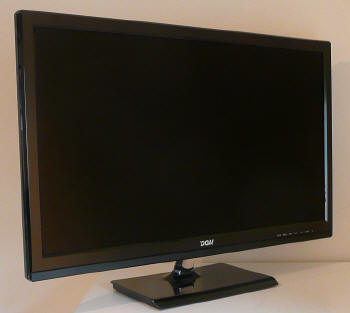
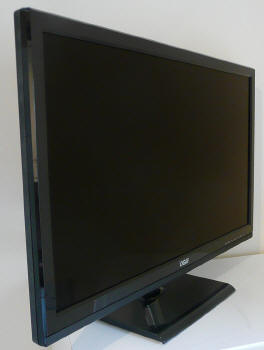
Above: front views of the screen. Click for larger versions
The DGM IPS-2701WPH comes in an all black
design, made with glossy piano black plastics for the bezel and base of
the stand. The bezel is pretty thin and measures ~24mm along the sides and
top, and is a little wider at ~38mm along the bottom edge. The plastic
trim does look attractive and fits in nicely with the overall glossy
appearance of the screen and panel. However, they do pick up finger prints
pretty quickly so you will need a cleaning cloth handy I expect,
especially if you are needing to adjust the angle of the tilt often.
One of the key selling points of this screen
is its glossy panel coating which is still pretty rare in the market,
especially on IPS models which are often criticised for their overly
aggressive anti-glare (AG) coating. With the glossy panel surface here,
whites look very clean and clear and you avoid any issues with grainy or
dirty look AG films. It should be noted that this is a glossy panel
surface treatment and there is not a layer of glass added to the front
like there was on the Hazro HZ27WA/C models. This avoids any issues with
trapped dust thankfully. The screen looks excellent and the glossiness
really does add to the 'feel' of the screen and the overall picture
quality. Of course it can be an issue with reflections, especially if you
have a window or light source behind you, so be wary of that.
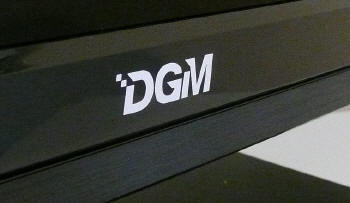
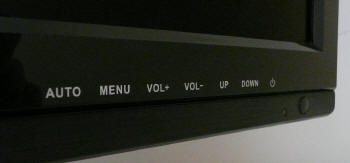
Above:
front view of lower bezel and OSD buttons. Click for larger versions
The bottom bezel features a light grey 'DGM'
logo in the middle as shown above. The only other writing on the screen is
then in the bottom right hand corner where the OSD control buttons are
situated. There is a thin matte plastic strip along the bottom edge which
you can see above which has a look almost as if it were a brushed
aluminium surface. It's quite a nice contrasting trim. The actual OSD
buttons are situated on the bottom edge of the screen out of sight, but
the labels on the bezel tell you what each will do. Note there is also a
round button on the front which would seem to be a power on/off button,
but in fact doesn't do anything on this screen. A small LED is situated
next to this which glows blue during normal operation and red when in
standby.
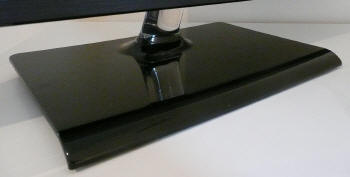
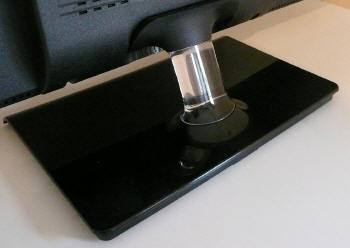
Above:
front and back view of the stand and base. Click for larger versions
The monitor has a small clear Perspex arm
which attaches to the back of the screen at the bottom. This then screws
simply into place into the glossy plastic base using the provided hand
screw. This base has a curved edge at the front and again, being glossy,
can pick up dust and finger prints quickly.
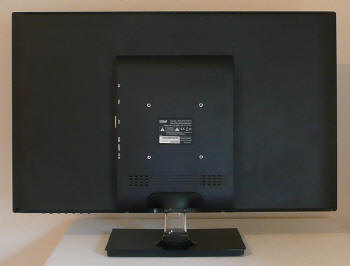
Above: rear
view of the screen. Click for larger version
The back of the screen is finished in a
matte black plastic as shown above. This is squared off, with only a
protruding centre section which houses the interface connections. These
are actually situated vertically along the left hand edge of that centre
section (as you look at it from behind).
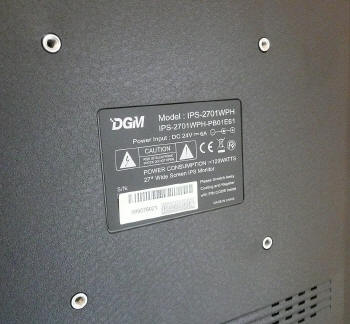
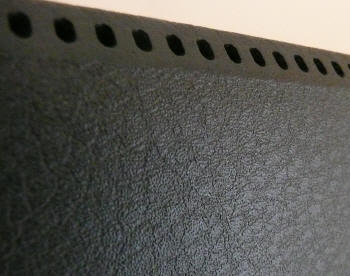
Above: rear
view showing VESA mounting holes and plastic finish. Click for larger
versions
The back of the screen features four VESA
mounting holes as shown above (100 x 100mm). The plastic on the back of
the screen has a finish which almost looks a bit like leather as you can
see from the other picture.
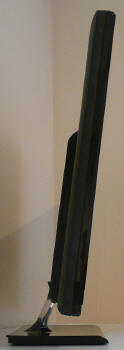
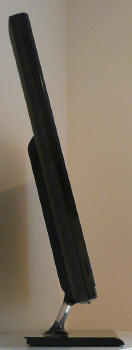
Above: Side
view showing full range of tilt adjustment. Click for larger versions
From the side, the screen has a pretty thin
profile thanks to the use of W-LED backlighting and an external power
supply unit. There is only a tilt function available from the stand which
offers a decent enough range of adjustment. The movement is stiff though
and you really need to grip the screen with both hands (resulting in
finger prints down the glossy bezel!) to move it around. When you do, the
screen can wobble quite a lot and even a light tap of the screen causes it
to move around a bit. The screen is obviously large and quite heavy and
this basic stand isn't ideal. It is possible to wall- or arm-mount the
screen but you will need to
remove the small arm which is a little tricky.
Fortunately we have produced a guide for you in the next section.
A summary of the screens ergonomic adjustments
is shown below:
|
Function |
Range |
Smoothness |
Ease of Use |
|
Tilt |
not specified |
Stiff |
Moderate |
|
Height |
n/a |
- |
- |
|
Swivel |
n/a |
- |
- |
|
Rotate |
n/a |
- |
- |
|
Overall |
Limited adjustments with only tilt available. Screen is
quite wobbly when
moved and tilt is stiff. |
The back of the screen features the interface
connections along the left hand side (as you look at it from behind) of the
centre section. These are aligned vertically and are pretty easy to access.
There are video connections for DisplayPort, D-sub (VGA), Dual-link DVI and
HDMI. Then there is a green audio input so you can feed sound from your PC and
play it through the integrated speakers. The last connection is for the power
supply provided. This is an external brick so you need to keep that in mind.

Above:
interface connections on the back of the screen. Click for larger version
The screen materials are of a decent quality it
seemed and the design is attractive in my opinion. The overall glossy feel of
the screen with its glossy bezel and screen coating looks very nice. The only
down-side really is the fact it can pick up finger prints quickly. There is no
audible buzz from the screen, even if you listen very closely. It also stays
nice and cool during use thanks to its low energy W-LED backlighting unit.

Removing the Stand - A
Guide
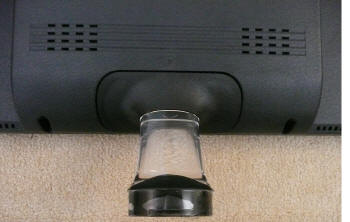
Click for
larger versions of pictures
The arm for the stand is actually attached to
the screen from within the main structure of the screen and it's not possible
to remove it without taking the screen apart a little. If you want to use the
VESA 100mm wall / arm mounting option you will want to remove the small,
stubby arm at the bottom. Fortunately
DGM have confirmed with Overclockers.co.uk (the exclusive provider of
these in the UK) that doing so will not invalidate the 3 year warranty, as long
as you do not remove the PCB or damage any part of the internal electronics or
casing. As long as you are careful, the following steps should allow you to
remove the stand easily enough. Please do so at your own risk, TFTCentral
cannot accept any responsibility for any damage you might cause. This is
purely provided as a guide to help you.
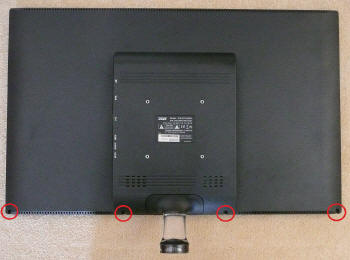
Click for
larger versions of pictures
The first thing you will need to do is unscrew
the 4 cross-head screws from the bottom edge of the screen as shown above.
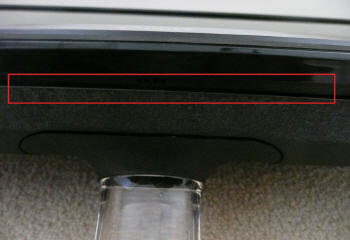
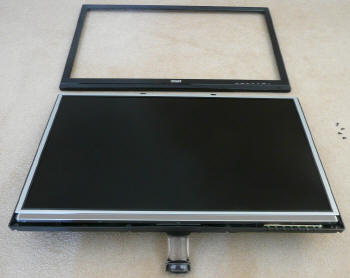
Click for
larger versions of pictures
If you then gently try to move the arm back and
forth you will notice that it causes the front plastic bezel of the screen to
pop away slightly from the back. The two halves of the screen are held
together by only plastic fasteners which snap into place so these need to be
gently pried apart. If you use a flat object like a ruler or a dinner knife (I
would not recommend a screw driver for this) you can slowly and gently pry this
away as you go round all 4 edges. The four corners are a little more tricky
but do snap away with a little force. Once you've done that you can completely
remove the front bezel as shown above.

Click for
larger versions of pictures
After this you need to just lift the main panel
out from the plastic back of the screen. It is held loosely in place by a
couple of clips either side as shown above.
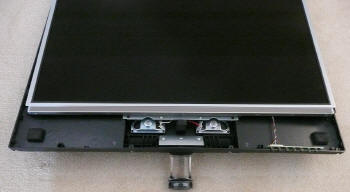
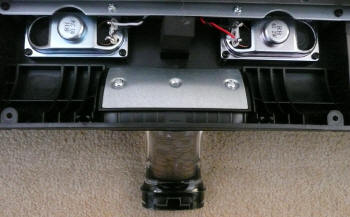
Click for
larger versions of pictures
The panel can be lifted out of the back and
needs to be moved up slightly. Don't move it to far as you will see it is
attached by a series of wires to things like the OSD control buttons and the
internal electronics. There's plenty of 'give' in it to move it up so you can
expose where the stand connects. You will see the stand is fastened by a small
metal plate and two screws to the back section of the screen.
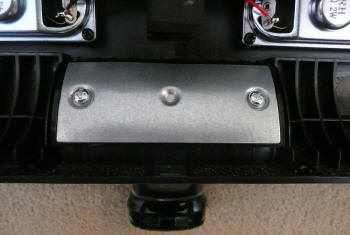
Click for
larger versions of pictures
By unscrewing the two screws shown above you can
remove the monitors arm. You can then put the screen back together, clipping
the bezel back into place tightly around all the edges and screwing the 4
screws back in on the back.

OSD Menu
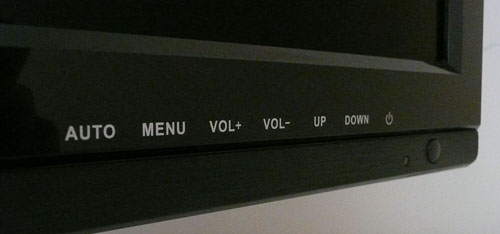
Above: view of
OSD operational buttons
The OSD menu and screen are controlled using a set
of 7 buttons located on the bottom edge of the screen in the right hand corner.
These are then labelled on the bezel as shown above, telling you what each
button will do. The far right button underneath is the power on/off button and
the small round button on the front of the screen does nothing.
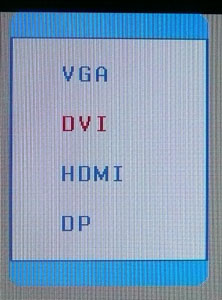
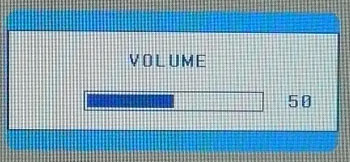
The buttons give you quick access to a few
features. The 'auto' button actually gives you quick access to the input select
which admittedly I missed the first time around, but is useful to have
available for quick switching. 'Menu' obviously pops up the full OSD menu which
we will look at in a moment. The 'Vol+' and 'Vol-' buttons give you quick access
to the adjustment of the speaker volume which is useful. This pops up a small
box in the middle of the screen as shown above, allowing you to control the
slider easily.
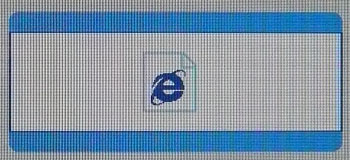
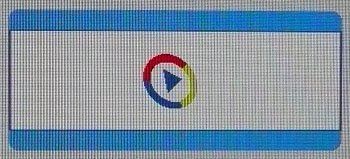
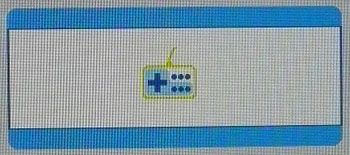
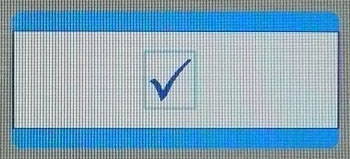
The 'up' button by default gives you quick access
to the range of so-called 'ECO modes', which are basically a series of 4
presets. These pop up a small graphic in the middle of the screen showing you
are switching between text, movie, game and standard modes.
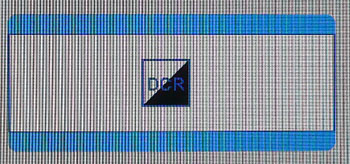
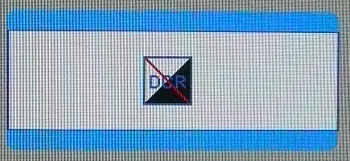
The 'down' button gives you quick access to the
DCR (dynamic
contrast ratio) function, again allowing you to turn this on and off, aided
by a small graphic in the middle of the screen. You can actually change the
options for these quick launch buttons if you want from within the main OSD. The
only other options though are ECO modes + aspect ratio control and brightness +
contrast controls.
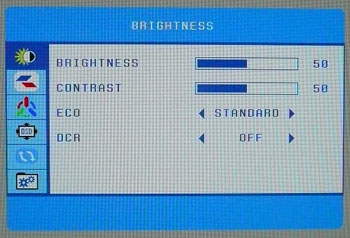
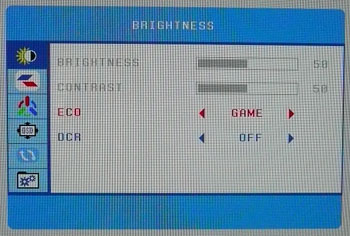
The main OSD menu is a fairly nice looking bit of
software which is split into 6 sections down the left hand side. Navigation
between these is achieved using the up and down buttons and the menu button
enters you into a section and then selects one of the options. The text turns
red for the option you are controlling. The only slightly fiddly thing though is
that once you have selected an option it is not the up and down arrows which
then change the setting, but instead you have to switch over and use the vol+
and vol- buttons. It takes a little getting used to and you do find yourself
hopping from button to button, having to feel your way to the right one
underneath the bottom edge of the screen.
The first section is labelled as the 'brightness'
section, giving you control over the brightness and contrast settings as a
starter. You can also control the ECO mode preset selection here and turn the
dynamic
contrast ratio on and off.
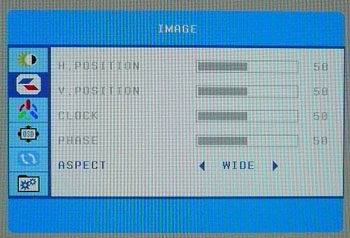
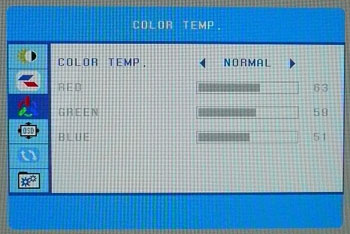
The second section is the 'image' menu, allowing
you to control a few features related to the use of the analogue VGA input. They
are greyed out here since we are using DL-DVI for testing. You can also control
the hardware level aspect ratio retention feature with options for wide and 4:3
available (we will look at these
later on). The third section is the 'color temp' menu allowing you to select
between 4 colour temperature modes if you want. There is a 'user' setting which
then allows you to adjust the RGB channels individually from within this same
section.
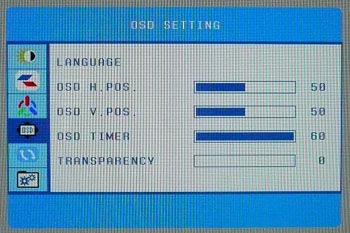
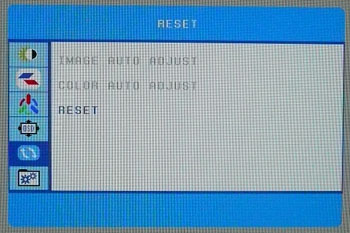
The fourth section allows you to control the OSD
behaviour as shown above, while the fifth section offers options to reset back
to defaults.
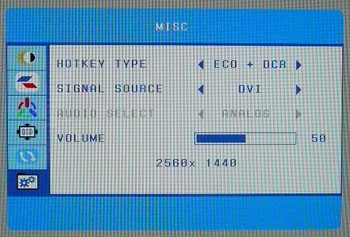
The sixth and final 'misc' section allows you to
control the quick launch options as explained earlier, choose your input source
and adjust the volume of the speakers.

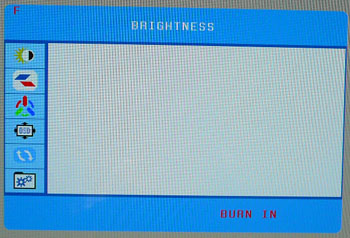
There is also a hidden factory menu available from
the screen. If you hold 'menu' while turning the screen on you can access this
yourself. It pops up a small box in the top left hand corner with red writing
confirming firmware and part numbers. This confirms the panel being used as well
which is the LG.Display LM270WQ1, as featured in other competing options
including the Apple 27" Cinema Display and Hazro HZ27WA/C/D models. If you then
press 'menu' the main OSD is mostly the same, except there is now a red label
saying "burn in" at the bottom, indicating that the burn in feature is enabled.
The menu sections are the same, except that if you scroll up above the
'brightness' section there is a seemingly blank section as shown above. Pressing
the 'menu' button again when you are selected on this blank section pops up a
more detailed factory menu shown below.
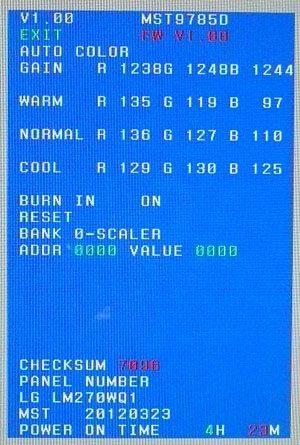
The factory menu confirms various things about the
screen and also allows you (if you want to - use entirely at your own risk) to
change the colour preset RGB levels and turn the burn-in feature on or off.
All in all the OSD was good I felt. There were a
decent range of options, especially considering this is a low cost screen and
some alternative competitors have done away with any OSD at all. Navigation was
ok, although the switching between the up/down and vol+/vol- buttons could be a
bit tricky sometimes.

Power Consumption
In terms of power consumption the manufacturers spec states
maximum
usage of 120W. In standby the screen apparently uses <1.5W.
|
 |
|
State and Brightness
Setting |
Power Usage
(W) |
|
Factory Default (50%) |
48.3 |
|
Calibrated (55%) |
53.9 |
|
Maximum Brightness (100%) |
104.2 |
|
Minimum Brightness (0%) |
24.2 |
|
Standby |
1.8 |
|
We tested this ourselves and found that out of the
box the screen used 48.3W of power while at its default brightness setting which
was 50%. At the maximum brightness setting the screen used 104.2W of power and at the lowest brightness setting, power
consumption was reduced to 24.2W. After calibration the brightness had been set
at 55% to achieve the desired luminance and this returned a power consumption of
53.9W. In standby the screen used 1.8W of power.
I have plotted the results of these measurements
on the graph below:


Panel and Backlighting
|
Panel Manufacturer |
LG.Display |
Colour Palette |
16.7 million |
|
Panel Technology |
H-IPS |
Colour Depth |
True 8-bit |
|
Panel Module |
LM270WQ1-SDE3 |
Colour space |
~sRGB |
|
Backlighting Type |
W-LED |
Colour space coverage (%) |
77% NTSC, 77.2% Adobe RGB, 99.9% sRGB |
The DGM IPS-2701WPH utilises an LG.Display
LM270WQ1-SDE3 H-IPS panel which is capable of producing 16.7 million colours with
a true 8-bit colour depth. We get asked quite a lot why some places refer to
modern IPS panels as "S-IPS" and others use the "H-IPS" name. Have a read of our
panel technologies article for more information, but they are just two
different types of IPS technology, with the new name being introduced when a
change in pixel alignment was introduced some years ago. H-IPS has a straight
vertical pixel structure whereas the older S-IPS panels had an arrow shaped
structure. This panel used here is based on the straight pixel structure so is
technically of the H-IPS classification. Again it should be noted that DGM have
confirmed they have selected A+ grade panels for this model. The panel is
confirmed below when dismantling the screen.
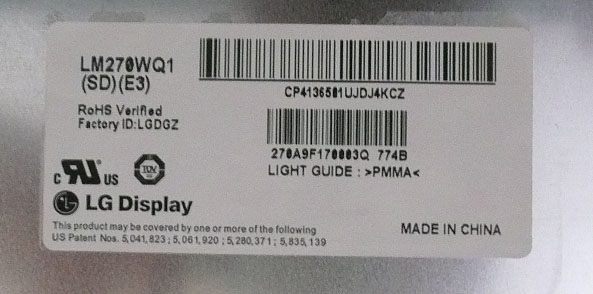
The IPS-2701WPH uses
White-LED (W-LED) backlighting producing a colour space
approximately equal to the sRGB reference. This means the screen is considered a 'standard gamut'
backlight type. Studying the detailed panel spec sheet confirms that the colour
space is equal to 77% of the NTSC space, 77.2% of the Adobe RGB reference and
99.9% of the sRGB space. A wide gamut screen would need to be
considered by those wanting to work outside of the sRGB colour space of course.
PWM Flicker Tests at Various
Backlight Brightness Settings
100%
50%
0%

|
Pulse Width
Modulation Used |
No |
|
Cycling
Frequency |
n/a |
|
Possible
Flicker at |
|
|
100% Brightness |
No |
|
50% Brightness |
No |
|
0% Brightness |
No |
We tested the screen to establish the methods used
to control backlight dimming. Our recent article talks in more details about a
common method used for this which is called
Pulse Width Modulation (PWM). A series of photos was taken using the method
outlined in the article. These were taken at 100%, 50% and 0% brightness
settings. This
allows us to establish 1) whether PWM is being used to control the backlight, 2)
the approximate frequency at which this operates, and 3) whether a flicker may be introduced
or potentially noticeable at certain settings.
A thin white line was shown on an all-black
background and a photograph was taken at a slow shutter speed of 1/8 second (in
this example) as
the camera was scanned left to right in front of the screen. This produces a
series of white lines which can be used to identify the frequency of the PWM and
how quickly the backlight is cycled on and off. The higher this frequency, the
less likely you are to see artefacts and flicker. The duty cycle (the time for
which the backlight is on) is also important and the shorter the duty cycle, the
more potential there is that you may see flicker. Please remember that not every
user would notice a flicker from the backlight but it is something to be wary
of. It is also a hard thing to quantify as it is very subjective when talking
about whether a user may or may not experience the side effects. We are able to
at least measure the frequency of the backlight using this method and tell you
whether the duty cycle is sufficiently short at certain settings that it may
introduce a flicker to those sensitive to it.
Interestingly the DGM IPS-2701WPH appears to not
use PWM at all for dimming of the backlight. Even at 0% brightness there was no
sign of the usual splitting of the white line that you'd expect to see in these
tests. We carried out the checks at an even slower shutter speed which returned
the same result. This is great news for those who are affected by flickering
backlights and suffer from eye fatigue and eye strain. There are very few
monitors which don't use PWM for backlight dimming (the
HP ZR2740w springs to mind as another), but this model does not.

Testing
Methodology
An
important thing to consider for most users is how a screen will perform out of
the box and with some basic manual adjustments. Since most users won't have
access to hardware colorimeter tools, it is important to understand how the
screen is going to perform in terms of colour accuracy for the average user.
I
restored my graphics card to default settings and disabled any previously active
ICC profiles and gamma corrections. The screen was tested at default factory settings using the DVI interface, and analysed using
an
X-rite i1
Pro Spectrophotometer (not to be confused with the new i1 Display Pro
colorimeter) combined with
LaCie's Blue Eye Pro software suite. An NEC branded and customised X-rite i1 Display 2 colorimeter was
also used to verify the black point and contrast ratio since the i1 Pro is less
reliable at the darker end.
Targets for these tests are as follows:
-
CIE Diagram - validates the colour space
covered by the monitors backlighting in a 2D view, with the black triangle representing the
displays gamut, and other reference colour spaces shown for comparison
-
Gamma - we aim for 2.2 which is the default
for computer monitors
-
Colour temperature / white point - we aim
for 6500k which is the temperature of daylight
-
Luminance - we aim for 120
cd/m2, which is
the recommended luminance for LCD monitors in normal lighting conditions
-
Black depth - we aim
for as low as possible to maximise shadow detail and to offer us the best
contrast ratio
-
Contrast ratio - we aim
for as high as possible. Any dynamic contrast ratio controls are turned off here
if present
-
dE average / maximum -
as low as possible.
If DeltaE >3, the color displayed is significantly different from the
theoretical one, meaning that the difference will be perceptible to the
viewer.
If DeltaE <2, LaCie considers the calibration a success; there remains a
slight difference, but it is barely undetectable.
If DeltaE < 1, the color fidelity is excellent.

Default Performance and
Setup
Default settings of the screen were as follows:
|
Monitor OSD Option |
Default Settings |
|
Brightness |
50 |
|
Contrast |
50 |
|
RGB Channels |
Locked (63, 59, 51) |
|
Color Temperature |
Normal |
|
ECO Preset mode |
Standard |

DGM IPS-2701WPH - Default Factory Settings



|
|
Default Settings |
|
luminance (cd/m2) |
109 |
|
Black Point (cd/m2) |
0.19 |
|
Contrast Ratio |
581:1 |
The default set of the screen actually felt very
good to the naked eye. Colours felt even and not too cold, not too warm. The
brightness was comfortable as well while the screen was set at its default 50%
brightness setting. You may note that by default the screen is in the 'normal'
colour temperature mode, where the RGB levels are locked at 63, 59 and 51
respectively. You are able to change these levels yourself by entering the
'user' colour temperature mode which we will test in a moment. We left the
screen in the default 'standard' ECO preset mode as well.
Out of the box the performance of the screen was
very pleasing. The
CIE diagram on the left confirms that the monitors colour gamut (black
triangle) matches the sRGB colour space (orange triangle) reasonably closely. It
extends a little past the sRGB space in some blues and reds in particular in
this 2D view of gamut which fits in with the fact we know it can cover ~77% of
the NTSC colour space, and so extends beyond sRGB slightly. There is pretty much
no under-coverage of the sRGB reference space and we know from the panel spec
that it can cover 99.9% of the sRGB reference which is great.

Default gamma was recorded at 2.2 average, leaving
it only 1% out from the target of 2.2 which was great. The gamma was a little
too high in darker grey tones where it ranged up to 2.33 maximum. Still, a good
default gamma setup from the screen which was good news. White point was
also very close to the target, being recorded at 6439k and being only 1% out. Note that we are using a
spectrophotometer to make these measurements which is not sensitive to the W-LED
backlight as some colorimeter devices can be. When using a standard gamut colorimeter
not designed to work with modern backlighting units like W-LED, there can be a typical deviance of 300 - 600k in the white
point measurement which is why some sources may refer to a different white point
in this test incorrectly.
Luminance was recorded at a modest and comfortable
109
cd/m2 which is
fine for general use. The black depth was a fairly poor 0.19 cd/m2
however, giving us a mediocre static contrast ratio of
only 518:1. This was behind some other modern IPS based screens we have tested.
We will see if it is possible to improve on this in a moment during our
calibration
process.
Colour accuracy was pretty good at default factory
settings with an average DeltaE (dE) of 2.4, ranging up to a maximum of 5.3.
Along with the good gamma and white point, this factory setup was very good
really, especially considering the low cost of the screen. The only area we were
disappointed with was the black depth / contrast ratio however.

Testing Colour Temperatures

The IPS-2701WPH features a range of colour
temperature
presets within the OSD 'Color temp' menu as shown above. We measured the screen
with the X-rite i1 Pro spectrophotometer in each of the preset modes to establish
their colour temperature / white point. All other settings were left at factory defaults and no
ICC profile was active. The results are recorded below:
|
Selected
Preset Mode |
Measured
Colour Temperature |
|
Normal |
6439k |
|
Cool |
8594k |
|
User (default) |
9444k |
|
Warm |
5612k |
The colour temperature modes labelled in words
as opposed to specific figures. We had already seen that the 'normal' setting
had returned a colour temperature very close (within 1%) to the 6500k target
in our tests which was great news. The cool setting was indeed cooler at 8594k
while the warm setting was warmer at 5612k. The user setting was very cool by
default, where the RGB channels were at their default 100, 100, 100 levels.
Changing those RGB channels will alter the colour temperature but does afford
you a decent level of control over the hardware itself.

Calibration Results
I wanted to calibrate and profile the screen to determine what was possible with optimum settings and
profiling. I used the
X-rite i1 Pro spectrophotometer
combined with the LaCie Blue Eye Pro software package to achieve these results
and reports. An NEC branded and customised X-rite i1 Display 2 was used to
validate the black depth and contrast ratios due to lower end limitations of the
i1 Pro device.

DGM IPS-2701WPH - Calibrated Settings
|
Monitor OSD Option |
Calibrated Settings |
|
Brightness |
55 |
|
Contrast |
60 |
|
RGB Channels |
100, 85, 75 |
|
Color Temperature |
User |
|
ECO Preset mode |
Standard |

|
|
Calibrated Settings |
|
luminance (cd/m2) |
120 |
|
Black Point (cd/m2) |
0.25 |
|
Contrast Ratio |
475:1 |
I first of all reverted to the 'user' mode in the color
temp section of the OSD menu which would allow me access to the individual RGB channels.
Adjustments were also made during the process to the brightness and contrast controls, and to
the RGB channels as shown in the table above. This allowed me to obtain an
optimum hardware starting point and setup before software level changes would be
made at the graphics card level. After this I let the software carry out the LUT adjustments and create an
ICC profile. The screen does not feature a hardware LUT calibration option
so other than the OSD alterations, the rest of the process is carried out at a
graphics card level in profiling the screen.
We already knew from our colour temperature tests
that the user mode by default was far too cool, which is why there is a big drop
in the green and blue channels needed in the OSD. The calibration was a great
success in most cases.

Average gamma had been corrected to 2.2 with 0%
deviance according to the initial test. Checking the more detailed table shown
above, the average gamma was actually 2.18, so it was rounded up to 2.2 in the
first report. Gamma was slightly closer to 2.2 in the darker shades than in the
light greys but overall the gamma curve was good. White point had been
maintained at within 1% of the target, now measured at 6537k. Luminance was now spot on at
120
cd/m2
thanks to the adjustment of the brightness and
contrast controls as shown. This gave us a fairly weak black level however of
0.25
cd/m2, and a
resulting calibrated static contrast ratio
of 475:1. We tried several different options to see if it was possible to
improve this through changes to the RGB channels and contrast control, but we
didn't have much luck. This did seem to be a weak point of this screen. Having
said that, subjectively the blacks looked good to the naked eye as the glossy
screen coating did make them 'pop' and look deep. In reality though the contrast
ratio was not as good as other IPS panels we have seen which can reach up to
~1000:1 in some cases. Colour accuracy was improved nicely though with dE
average now only 0.4, and maximum 1.3. LaCie would consider colour fidelity to
be excellent overall.
Testing the screen with various colour gradients
showed mostly very smooth transitions. There was some gradation in darker tones
and some very slight banding introduced due to the adjustments to the graphics
card LUT from the profilation of the screen. Nothing major at all though. It's
worth also commenting on the screen coating in this section of the review.
Unlike most other IPS panels, this screen does not feature the usual grainy and
dirty looking Anti-glare (AG) coating. Instead it uses a glossy screen coating
and as a result the colours look very clean and crisp, the image quality is
sharp and whites in particular look a lot more pure than they do on heavy AG coated
screens. Glossy coating isn't to everyone's taste though as it can introduce
reflections which are annoying. You should probably try and see a glossy and an
AG panel in person if you are unsure what to buy.
You can use our settings and
try our calibrated ICC profile if you wish, which are available in
our ICC profile database. Keep in mind that results will vary from one
screen to another and from one computer / graphics card to another.

Calibration
Performance Comparisons

I've provided a comparison above of the
IPS-2701WPH against some of the other screens we have tested. Out of the box
average dE was 2.4 which was pretty decent really and combined with the good
default gamma, white point and luminance represented a good factory calibration.
It offered a similar level of accuracy to the
HP ZR2740w (2.2) which is another 27" IPS + W-LED model and was also quite
close to the
Hazro HZ27WC model (dE 1.5 average) which is its closest rival in the UK
really. The Hazro HZ27WC also had a good factory setup in terms of gamma and
white point, although it was a little too bright out of the box. It seems even
though the HZ27WC and this IPS-2701WPH are low cost options, their initial setup
is good.
All these screens were ahead of some of the other
27" models like the AMVA based
BenQ EW2730V (6.5) for instance and the PLS based
Samsung S27A850D (3.6). The professional grade 27"
NEC
PA271W and
SpectraView Reference 271 were better thought as you might expect at 1.1 dE and 1.5 dE average
respectively.

Once calibrated the dE average was reduced to 0.4.
This would be classified as excellent colour fidelity by LaCie. It was not quite
as low as some of the other screens here which reached down to 0.2 average, but
in practice you would not notice any difference here. Some of the
professional range models from NEC are even more accurate. Professional grade
monitors like the NEC PA series and P241W also offer other high end features which
separate them from some of these other models, including extended internal
processing, 3D LUT's and hardware calibration. These comparisons are based on a
small selection of tests, so it should be remembered that other factors do come
into play when you start talking about professional use. For further information
and tests of a high end professional grade screen with hardware LUT calibration,
you may want to have a read of our
NEC SpectraView Reference 271 review.
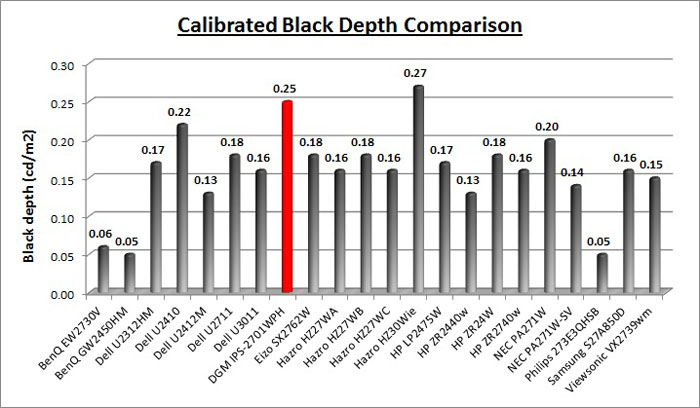
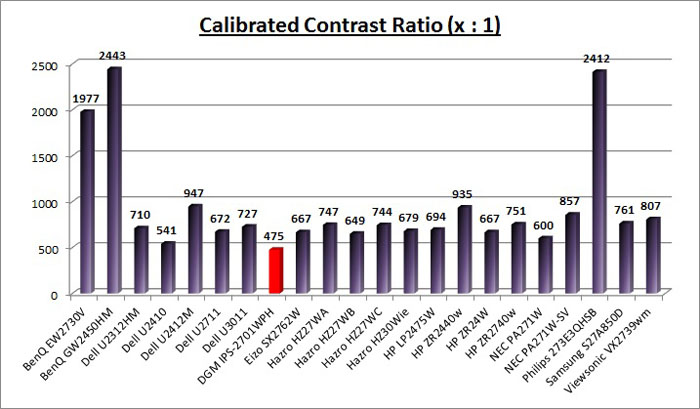
The calibrated black depth and contrast ratio of
the IPS-2701WPH were a little disappointing really and this is probably the main
weakness of the panel. Black depth was only 0.25
cd/m2 after
calibration and this gave us a static contrast ratio of 475:1. This was not very
good for a modern IPS panel and we have seen figures of up to ~1000:1 in some
cases. Some other IPS based 27" models are also not great in this area, such as
the Dell U2711 (672:1) and NEC PA271W (600:1) but even so we would have hoped
for a little more than 475:1 from the DGM. Having said that, because of the
glossy screen coating, the blacks do look and feel pretty good and subjectively
the contrast doesn't look too bad.

Contrast
Stability
I wanted to see how much variance there was in the screens contrast as we
adjusted the monitor setting for brightness.
In theory, brightness and contrast are two independent parameters, and good
contrast is a requirement regardless of the brightness adjustment.
Unfortunately, such is not always the case in practice. We recorded the
screens luminance and black depth at various OSD brightness settings, and
calculated the contrast ratio from there. Graphics card settings were left at
default with no ICC profile or calibration active. Tests were made using an
NEC branded and customised
X-rite i1 Display 2 colorimeter. It should be noted that we used the
BasICColor calibration software here to record these, and so luminance at
default settings may vary a little from the LaCie Blue Eye Pro report.
|
OSD Brightness |
Luminance
(cd/m2) |
Black Point (cd/m2) |
Contrast Ratio
( x:1) |
|
100 |
291.6 |
0.52 |
561 |
|
90 |
264.3 |
0.50 |
529 |
|
80 |
234.8 |
0.45 |
522 |
|
70 |
200.1 |
0.38 |
527 |
|
60 |
158.5 |
0.30 |
528 |
|
50 |
107.4 |
0.20 |
537 |
|
40 |
84.0 |
0.16 |
525 |
|
30 |
67.9 |
0.12 |
566 |
|
20 |
50.5 |
0.09 |
562 |
|
10 |
31.9 |
0.06 |
532 |
|
0 |
11.9 |
0.02 |
592 |
|
Luminance Adjustment Range = 279.7 cd/m2
Black
Point Adjustment Range = 0.5 cd/m2
Average
Contrast Ratio = 544:1
|
The luminance range of the screen was very wide
indeed. At a maximum brightness setting the screen reached 291.6
cd/m2 which was
a little shy of the specified 350 cd/m2 maximum. This could be
adjusted all the way down to a very low 11.9 cd/m2 through changes to
the brightness control, giving you a 279.7 cd/m2 adjustment range.
Black depth ranged from 0.52 to 0.02 cd/m2 but the overall static
contrast ratio was on average ~544:1 which wasn't great unfortunately.

We have plotted the
luminance trend on the graph above. The screen behaves as it should, with a reduction in the backlight intensity controlled by the reduction
in the OSD brightness setting. This isn't a linear relationship though as the
top 50% of the adjustment range seems to make steeper changes to the luminance
than the bottom 50% of the range.
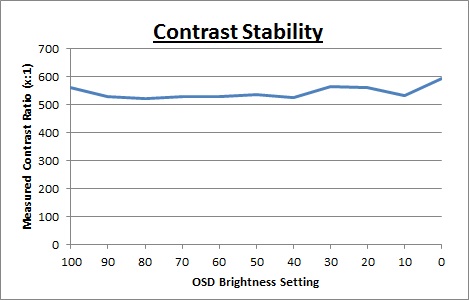
Static contrast ratio was
not great, with an average of 544:1. This was fairly stable across the range,
but did seem to be slightly higher between a setting of 40 - 0%.

Dynamic Contrast
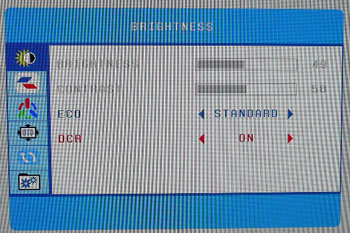
The DGM IPS-2701WPH features a dynamic contrast
ratio (DCR) control within the OSD menu and the manufacturers spec boasts a
DCR of a reasonably modest 80,000:1. Dynamic contrast ratio involves controlling the
backlight of the screen automatically, depending on the content shown on the
screen. In bright images, the backlight is increased, and in darker images, it
is decreased. We have come to learn that DCR figures are greatly exaggerated
and what is useable in reality is often very different to what is written on
paper or on a manufacturers website.
For this test I would use the colorimeter to record the
luminance and black depths at the two extremes. Max brightness would be
recorded on an almost all white screen. Black depth would
be recorded on an almost all black screen. In real use you are very
unlikely to ever see a full black or full white screen, and even our tests are
an extreme case to be honest. Carrying out the tests in this way does give you
a good indication of the screens dynamic contrast ratio in real life
situations however.
The DCR feature is available in all four preset modes, and it has
a simple on or off setting you can select. Once enabled, the brightness and
contrast controls in the OSD are greyed out.
|
|
Dynamic Contrast |
|
Specified DCR Range |
80,000: 1 |
|
Available in Presets |
All |
|
Settings |
On / Off |
|
Max luminance (cd/m2) |
329.4 |
|
Min Black Point (cd/m2) |
0.52 |
|
Max Dynamic Contrast Ratio |
634:1 |
We tested the DCR feature and you could
immediately notice the screen getting much brighter when you first turn it on.
In fact on an almost all-white screen the luminance reached up to 329.4
cd/m2 which was
even a bit higher than we'd seen through the normal brightness controls.
However, switching to an almost all-black screen didn't seem to do anything and
the screen appearance did not change. We measured black depth at 0.52 cd/m2
and so the dynamic contrast ratio being produced was only 634:1. We tested the
screen again with a completely 100% all-black screen and you could see (by
having the OSD menu open) that the backlight was now being controlled and it
took about 3 seconds to change from maximum to minimum brightness. It looks like
another screen where
the feature can work to
a degree, but only in the most unrealistic and extreme circumstances which you
will probably never experience in real use.
Unlike some models from Asus and LG however
we did not see the backlight being turned completely off and so what you are
basically doing is controlling the full range of the backlight intensity in the
space of around 3 seconds. In real use you are never going to have a 100% black
screen so the use of this feature is very questionable. If it did operate under
less extreme circumstances you could in theory get a maximum luminance of 329.4
cd/m2 and a minimum black level of probably around 0.02 cd/m2.
That black depth figure is taken from our contrast stability section and would
in theory give you a dynamic contrast ratio of ~16,500:1. That would be a fairly
reasonable figure and may be of use to some people at least. The screen would
never live up to its 80,000:1 spec though as you would have to be turning the
backlight off to reach a lower black point than 0.02 cd/m2 it seems.
In fact it would be
then tending towards infinity:1 if you consider its black point is basically
then 0 cd/m2
if that did happen. However, in practice you are never going to be able to see a
DCR range like that. In fact in normal use the DCR doesn't seem to operate at
all. Another marketing gimmick and a disappointing trend we've seen from a lot
of other screens.
We would like to start seeing realistic DCR
figures being quoted from manufacturer really, not made up numbers which don't
translate into real performance. I'd rather see a screen with a useable DCR of
~10,000:1 for example than a screen with an advertised 100 million:1 which
only works in the most extreme and unrealistic circumstances that a user will
never see.

Viewing Angles

Above: Viewing
angles shown from front and side, and from above and below. Click for
larger image
Viewing angles of the IPS-2701WPH were very good
as you would expect from an IPS based panel. Horizontally there was very little
colour tone shift until wide angles past about 45°. Contrast shifts were
slightly more noticeable in the vertical field but overall they were very good.
The screen did offer the wide viewing angles of IPS technology and was free from
the very restrictive fields of view of TN Film panels, especially in the
vertical plane. It was also free of the off-centre contrast shift you see from
VA panels and a lot of the quite obvious gamma and colour tone shift you see
from some of the modern AMVA and PVA offerings.
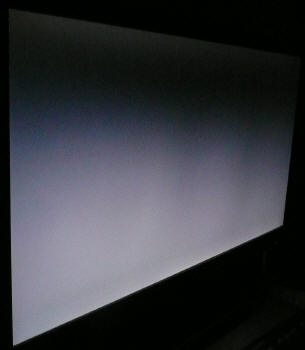
Above: View of an all black screen from the side. Click for larger version
On a black image there is a characteristics IPS
white glow, but in normal working conditions this shouldn't present too much of
a problem. The above image was taken in a darkened room to demonstrate the white
wide angle glow when viewing a black screen. There is no A-TW polarizer on this
panel which is rarely used now in the market but was implemented on some older
screens to improve the off centre black viewing. If you are viewing dark content
from a close position to the screen you can sometimes see this pale glow on
parts of the screen towards the sides and corners because of your proximity to
the screen and your line of sight. This is accentuated a little due to the sheer
size of the 27" panel. The edges of the screen are at an angle from your line of
sight which means you pick up this white glow to a smaller degree. This
disappears as you move backwards away from the screen where the line of sight
does not result in a wide angle view of parts of the screen and you can see the
screen largely from head on. That is a little difficult to explain but hopefully
makes sense. It is only really apparent on darker content and only really if you
are working in darkened lighting conditions on this model. It was not too severe
I didn't think, but something to be aware of.

Panel Uniformity
Measurements of the screens luminance were taken
at 35 points across the panel on a pure white background. The measurements were
taken using BasICColor's calibration software package, combined with the NEC
customised X-rite
i1 Display 2 colorimeter. The above uniformity diagram shows the difference, as
a percentage, between the luminance recorded at each point on the screen, as
compared with the reference point of a calibrated 120 cd/m2. This is
the desired level of luminance for an LCD screen in normal lighting conditions,
and the below shows the variance in the luminance across the screen
compared with this point. It is worth noting that panel uniformity can vary from
one screen to another, and can depend on manufacturing lines, screen transport
and other local factors. This is only a guide of the uniformity of the sample
screen we have for review.
Uniformity of Luminance

The luminance uniformity of the IPS-2701WPH
was very good overall. There was some slight variance in luminance,
particularly along the bottom edge but only by about -19% in the most
extreme cases. Along this edge the luminance ranged down to 101
cd/m2 but the central regions of the
screen were much closer to the target 120 cd/m2 and within ~5% on
the most part. Approximately two thirds of the screen was within 10%
deviance of the 120 cd/m2 central point which was good.
Backlight Leakage
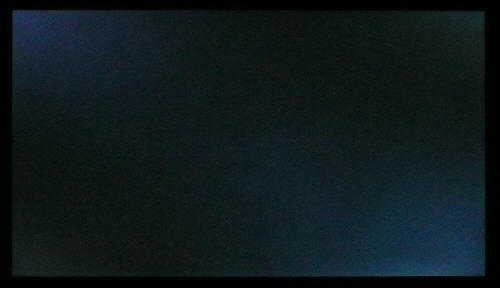
Above: All black screen in a darkened room. Click for larger version
As usual we also tested the screen with an all
black image and in a darkened room. A camera was used to capture the result. To
the naked eye, there did not appear to be much in the way of backlight leakage
although you could notice the characteristic IPS-glow as you looked at the black
image from different angles. The camera picked out some slight unevenness and
some clouding from the backlight in the corners. This was most apparent in the
bottom right hand corner but in practice overall there was nothing too severe.
There was no bleeding from the edges which was good to see as that can become
quite distracting during some uses, for instance when watching a movie with
black borders top and bottom.

General and Office Applications
The IPS-2701WPH features a massive 2560 x 1440
WQHD resolution which is only just a little bit less vertically than a 30"
screen. The pixel pitch of 0.233mm is very small as a result, and by comparison
a standard 16:10 format 24" model has a pixel pitch of 0.270mm and a 30" model
has 0.250mm. These ultra-high res 27" models offer the tightest pixel pitch and
therefore the smallest text as well. I don't find it too small personally, but
day to day I am used to a 24" screen. Some users may find the small text a
little too small to read comfortably, and I'd advise caution if you are coming
from a 19" or 22" screen for instance where the pixel pitch and text are much
larger. I found a 30" screen to be quite a change with text size when I first
used one, and this is very similar and even a little bit smaller! I still
personally prefer the slightly larger text of a 24" model myself, but I expect I
could happily get used to the added resolution on these models given time.
The massive resolution is really good for office
and general use, giving you a really big screen area to work with. It is a
noticeable upgrade from a 24" 1920 x 1200 resolution, and it's good to see DGM
have opted for the high res panel here rather than sticking with another 1920 x
1200 or 1920 x 1080 res panel as you may find in other older 27" models. For
those wanting a high resolution for CAD, design, photo work etc, this is a
really good option. The image was very sharp and crisp and text was very clear.
The glossy screen coating ensured that the white backgrounds of office documents
looked clean and pure, and did not suffer from the grainy and dirty feel of some
IPS panels featuring aggressive AG coating. Being glossy though it did introduce
some reflections which were a bit of a pain sometimes. You will want to ensure
you don't have the screen facing a window or strong light source I would think.
There were four preset modes available from the
'ECO mode' menu, all of which seemed to be cooler than our calibrated standard
profile when at their defaults. They might be useful to some users though and
there is a 'text' setting available if you want. The brightness control also
allows you to control a huge range of adjustment to the luminance of the screen
which is excellent. Even out of the box, the 50% default brightness is
comfortable for office use and measured at around 109
cd/m2 in our tests. A setting of around
55% should return you a luminance close to 120 cd/m2 for office use
if you want, and you are able to control the brightness all the way down to
around 11 cd/m2 at the 0% setting which is excellent. Those wanting
to use the screen in low lighting conditions shouldn't have any issue here.
Another thing to note while we are talking about the brightness control is that
the screen does not use
Pulse-Width modulation (PWM) to control backlight dimming and so those who
suffer from eye fatigue or headaches, associated with flickering backlights,
need not worry here.
The stand provided offers limited adjustments
unfortunately. The tilt function allows for a reasonable range of angles to get
a comfortable setup, but unfortunately there is no height adjustment which might
be missed by some people. There is no rotate function either to switch between
portrait and landscape modes, but the practicalities of using that on a screen
this size are questionable. If you want to, you can wall or arm mount the screen
though for improved flexibility. The integrated speakers should be adequate for
general office sounds and light music as well. There are no further extras like
USB ports or card readers here sadly, but the interface range is very good. With
DisplayPort and DL-DVI both supporting the full 2560 x 1440 resolution you
should have a decent choice for your PC. Since the VGA input was not able to
support the full resolution of the screen we did not compare the sharpness of
the image between analogue and digital, but the digital picture quality was
excellent.

Above: photo of
text at 2560 x 1440 (top) and 1920 x 1080 (bottom)
The screen is designed to run at its native
resolution of 2560 x 1440 and at 60Hz refresh rate. If you want to you can run
it outside of this and let the image be scaled to fill the screen. At the native
resolution text was very sharp and clear. We ran the screen at 1920 x 1080 which
was the next step down, while still maintaining the screens 16:9 aspect ratio.
Text was actually very good and was hardly blurred at all. The screen is
perfectly capable of being run at a lower 1920 x 1080 resolution if you wanted
to, without much degradation in the picture quality and sharpness. To give you
more desktop real estate and maximum picture quality, the native resolution is
of course recommended where possible.

Responsiveness and Gaming
The IPS-2701WPH is rated by DGM as having a
6ms G2G response time which implies the use of
overdrive /
response time compensation (RTC) technology, used to boost pixel
transitions across grey to grey changes. The panel being used is an
LG.Display LM270WQ1-SDE3 H-IPS panel. Unlike quite a lot of screens we have
tested recently there is no control over this overdrive impulse from within the
OSD, and so you will have to rely on the setup by the manufacturer here.
The screen was tested using the moving car test
in PixPerAn for the display comparisons. As a reminder, a series of pictures are
taken on the highest shutter speed and compared, with the best case example
shown on the left, and worst case example on the right. This should only be used
as a rough guide to comparative responsiveness but is handy for a direct
comparison of the impact of this setting:

27" 6ms G2G
LG.Display H-IPS

27"
6ms G2G LG.Display H-IPS

27"
6ms G2G LG.Display H-IPS

27"
6ms G2G LG.Display H-IPS

27" 12ms G2G
LG.Display H-IPS
I have provided a comparison of the IPS-2701WPH first of all against some of the
other 27" IPS based screens we have tested. You will see first of all a
comparison against the
Hazro HZ27WC and HZ27WA which are the closest rivals to the DGM really in the
UK. Both are also low cost screens with standard gamut IPS panels and a glossy
screen coating. The responsiveness of the IPS-2701WPH was good in practice and
the moving image showed no noticeable ghosting. There was a slight blur to the
image as you might expect but overall we were pleased with the pixel response
times here in this test. It produced very similar results to the Hazro HZ27WC in
fact, both with only a feint trail behind the moving car in the photos above.
The Hazro HZ27WA had not been quite as good as it had produced a dark overshoot
artefact through the slightly too aggressive overdrive impulse. This was even
more pronounced on the
Dell U2711 in fact, and while these two models did offer low levels of
motion blur, they did suffer a little because of this overshoot. The
HP ZR2740w was pretty good in these tests as well although a little slower
than the IPS-2701WPH with a more noticeable blur.

27" 6ms G2G
LG.Display H-IPS

27" 5ms G2G
Samsung PLS (response time = faster)

27" 6ms G2G AU
Optronics AMVA (SmartResponse = Fastest)

27" 8ms G2G AU
Optronics AMVA (AMA setting = Premium)
If you then compare the IPS-2701WPH with 3 other 27" screens we have tested which use
AMVA or PLS panel technology
there are more pronounced differences in some cases.
The
Samsung S27A850D had impressed us in these tests with its PLS panel
technology and with a fast response time and very low levels of motion blur. It
remained a little ahead of the IPS-2701WPH in fact. The
Philips 273E3QHSB and
BenQ EW2730V are based on AMVA panel technology and fell behind in these
tests. The generation of AMVA panel being used in those two models was not able
to compete with the responsiveness of modern IPS or PLS displays and there were
quite high levels of blur evident, even with their response time controls turned
up to the optimum levels. Those screens are rated with a 6ms and 8ms G2G
response time respectively which just goes to show you can't always trust a
specification when determining real life performance of a display.

27" 6ms G2G
LG.Display H-IPS

24" 6ms G2G
LG.Display e-IPS (Video OverDrive = On)

24" 8ms G2G
LG.Display e-IPS

23" 8ms G2G
LG.Display e-IPS (W-LED)

24" 4ms G2G AU
Optronics AMVA (AMA = Premium)
Above is a comparison of the IPS-2701WPH against some popular models in smaller
sizes. First are three models using IPS panels, but n smaller sizes of 24" and
23". The
HP ZR2440w had performed very well in these tests and showed a lower
level of motion blur to the IPS-2701WPH in practice. There was a very slight dark and
pale halo trail evident in those tests but it was very slight. The
Dell U2412M and
U2312HM again offered low levels of motion blur but a more obvious dark
overshoot trail was introduced. The larger 27" IPS panel of the IPS-2701WPH was
not quite as fast as these smaller IPS screens but was at least free from any
dark overshoot. I have also included the results from our recent review of the
BenQ GW2450HM since there had been some big improvements made in AMVA panel
technology in this most recent generation of panel. Thankfully the
responsiveness was much better than we'd seen from the
Philips 273E3QHSB and
BenQ EW2730V we showed you above and was on par in practice with these IPS
screens.

27" 6ms G2G
LG.Display H-IPS

27" 1ms G2G CMO
TN Film (Response time mode = Advanced)

24" 2ms G2G AU
Optronics TN Film (AMA = On + 120Hz)

22" 3ms G2G Samsung TN Film + 120Hz
I've also included a comparison above against 3
gamer-orientated screens, including the 27" TN Film based
ViewSonic VX2739wm.
While it is the same size as the DGM IPS-2701WPH, it is very different of
course. That model is
aimed primarily at gamers and even has a 1ms G2G quoted response time. It also uses a TN Film panel
and so has restrictions in some areas, such as viewing angles. It
performs a bit better than the IPS-2701WPH though in these tests as you might
hope. It is of course as expected considering it is a gamer-orientated TN Film
model.
The other two models here both featuring heavily
overdriven TN Film panels, and are combined with 120Hz technology. The pixel
responsiveness of both of these is also a little ahead of the IPS-2701WPH, but more
importantly the 120Hz frequency
allows for improved 120fps frame rates and the support of
3D
stereoscopic content as well.
The recently tested
BenQ XL2420T
offers some very fast performance and is a screen purely aimed at gamers. The
Samsung 2233RZ arguably remains our champion if we base it purely on the responsiveness
tests. Both these screens do perform faster in practice though thanks to their
120Hz support, giving you smoother moving images and higher frame rates.
The responsiveness of the IPS-2701WPH was pleasing we felt. It offered no
obvious ghosting and only low levels of motion blur. It could compete easily
with the other 27" IPS models we had tested and showed a sharp moving image,
free of any noticeable overshoot artefacts which had affected some of its
competitors. The screen should be perfectly capable of handling fast paced
games, although you may want to consider the type of graphics card required to
run games with high settings at such a high resolution. Thankfully we'd also
seen good image interpolation at lower resolutions and so gaming with an input
resolution of 1920 x 1080 (for instance) is also very viable.
Additional Gaming Features

Aspect Ratio Control - The screen offers
two options within the OSD menu for hardware level
aspect ratio control. There are settings for 'wide' which will fill
the whole screen regardless of the input resolution, and for '4:3'. Normally you
would expect this mode to force the screen to a 4:3 aspect ratio display, regardless
again of the input resolution. In reality it seemed to behave quite differently.
Some resolutions would always be shown full
screen, regardless of whether you had set the display to wide or 4:3. For
instance a 1920 x 1200 (16:10 aspect) or a 1600 x 1200 resolution (4:3 aspect)
seemed to always be stretched to fill the screen. Some other lower 16:10 aspect
ratio resolutions such as 1680 x 1050 and 1440 x 900 had black borders down the
sides when in 4:3 mode, but the aspect ratio shown was not actually 4:3, it was
the 16:10 of the source (always stretched to fill as much of the screen as
possible though but maintaining the aspect ratio). Some lower than native 16:9
aspect resolutions like 1600 x 900 would show with black borders down the sides,
but would be stretched vertically into a 16:10 aspect ratio. In this example
switching to the 'wide' mode would fill the screen and correct the aspect ratio
back to 16:9. Other lower resolutions still like 1280 x 1024 was maintained at
its native 5:4 aspect ratio while proper 4:3 input resolutions like 1280 x 960
ended up being stretched into 5:4 aspect ratio.
There didn't seem to be a pattern to it really,
sometimes the 4:3 mode retained a 16:10 aspect ratio, sometimes it retained a
5:4 aspect ratio, and other times when it should have been supporting a 4:3
aspect, it filled the screen completely or changed it to 5:4! We have produced a
table showing these results below for reference. If you do need to run anything
outside of the native aspect ratio then be wary of this hardware limitation, or
better still, rely on your graphics card or input device to do the aspect
ratio control for you.
|
Input resolution |
Result of setting screen mode to 4:3 |
|
1920 x
1440 |
always
fills the screen |
|
1920 x
1200 |
always
fills the screen |
|
1920 x
1080 |
always
fills the screen |
|
1680 x
1050 |
maintains 16:10 aspect ratio |
|
1600 x
1200 |
always
fills the screen |
|
1600 x
900 |
bars
down the side, but stretched vertically to 16:10 instead of 16:9, but
switching to 'wide' would be correct aspect ratio to fill the screen |
|
1440 x
900 |
maintains 16:10 aspect ratio |
|
1280 x
1024 |
actually maintains 5:4 aspect ratio |
|
1280 x
960 |
stretches 4:3 aspect vertically to 5:4 |
|
1280 x
720 |
always
fills the screen |
|
1024 x
768 |
maintains 4:3 aspect ratio |
|
800 x
600 |
maintains 4:3 aspect ratio |
Preset Modes - There is a 'game' preset
mode available from within the ECO mode menu. When using these other presets it
seems that the brightness and contrast options are greyed out and locked to
whatever you had them set at in the 'standard' mode. They also have a defined
RGB / colour temperature setup and even changing the colour temperature mode
doesn't change anything while you're in the game preset. When you revert back to
the standard mode though the changes you have made (e.g. changing the colour
temperature setting) have changed. Anyway, there is a game preset mode available
if you want and it might be useful as an alternative to how you've set up the
standard preset. The
dynamic contrast
option is available in all the preset modes but in practice it doesn't really
work, unless you show a 100% all-black screen which is never really going to
happen.

Input Lag
We have recently written an in depth article about
input
lag and the various measurement techniques which are used to evaluate this
aspect of a display. We have also improved our method by adopting the SMTT 2.0
tool which is used to generate the results below. Please see our full
input
lag testing article for all the details.
Input Lag Classification
To help in this section we will also introduce a broader classification system
for these results to help categorise each screen as one of the following levels:
-
Class 1)
Less than 16ms / 1 frame lag - should be fine for gamers, even at high levels
-
Class
2)
A lag of 16 -
32ms / One to two frames - moderate lag but should be fine for many gamers.
Caution advised for serious gaming and FPS
-
Class
3)
A lag of more
than 32ms / more than 2 frames - Some noticeable lag in daily usage, not
suitable for high end gaming
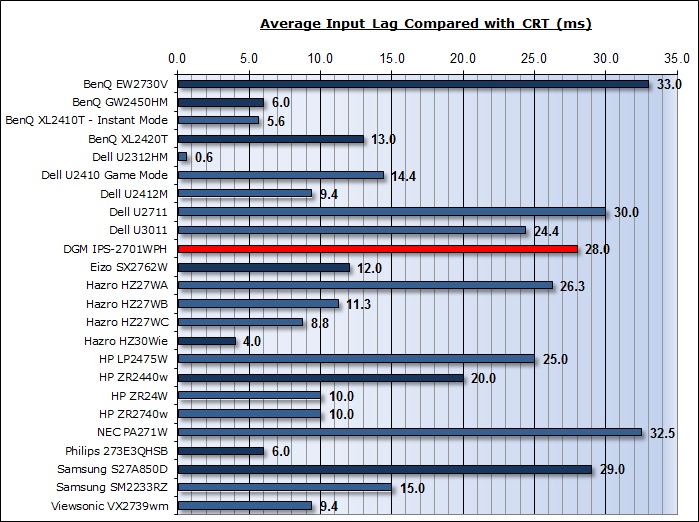
For the full reviews of the models compared here and the dates they were written
(and when screens were approximately released to the market), please see our
full
reviews index.
Our tests here are based on the new format using
SMTT 2.0. We have provided a comparison above against other models we have
tested to give an indication between screens. However, please note that many of
the other screens tested here were using older stopwatch methods and not the
SMTT 2.0 tool. For reference, those shown as darker blue lines were tested using
SMTT 2.0.
The DGM IPS-2701WPH showed an average display
input lag of 28ms during this test, ranging up to 30ms maximum. This was not too
severe, but a bit higher than we had seen from some other recent screens, and
represented a lag of close to 2 frames. The lag of this screen has been
categorised as CLASS 2 as detailed above.

Movies and Video

The following summarises the screens performance
in video applications:
-
27"
screen size makes it a pretty good option for an all-in-one multimedia screen
and comparable to smaller LCD TV's in size. A screen this big really does help
lend itself to video viewing.
-
16:9
aspect ratio is more suited to videos than a 16:10 format screen, as it leaves
smaller borders on DVD's and wide screen content.
-
Native
2560 x 1440 resolution can easily support true 1080 HD content (1920 x 1080
resolution)
-
Digital
DL-DVI, DisplayPort and HDMI interfaces support HDCP for any encrypted and
protected content
-
Good to
see DisplayPort and HDMI provided for connection of additional devices, both
of which are very popular for external DVD and Blu-ray players.
-
Glossy
screen coating can look attractive but may cause issues with reflections
depending on room conditions and light sources. Perhaps not as suitable as an
anti-glare coating for this purpose.
-
Contrast
ratio was not great sadly. It should be ok for movie use and on the most part
detail in darker scenes and shadow detail should not be lost but if you are
watching a lot of dark content it might cause some issues.
-
Dynamic
contrast ratio is available but doesn't really work in practice. You have to
have a 100% black screen for it to function which is probably never going to
happen in real use.
-
There is
a 'movie' preset mode available in the OSD ECO mode if you want to set up a
mode specifically for your movie viewing
-
Good
pixel responsiveness for movies and video which should be able to handle fast
moving scenes without issue.
-
Wide
viewing angles thanks to IPS panel technology meaning several people could
view the screen at once comfortable and from a whole host of different angles.
The IPS glow from an angle might present a problem on darker content depending
on your line or sight and distance from the screen
-
Limited
ergonomic adjustments available from the stand with only a basic tilt
available. Would have been useful to see height adjustment as well.
-
No
obvious backlight leakage from the edges which is good. This type of leakage
may prove an issue when watching movies where black borders are present but it
is not a problem here. Some slight clouding in the corners which might become
evident in darkened room conditions sometimes.
-
Integrated stereo speakers available if you want, along with audio
pass-through and a headphone socket. Might be useful for the occasional video
but of course the speakers aren't up to a great deal.
-
No
picture in picture (PiP) or picture by picture (PbP) modes available on this
model.

Conclusion
The DGM-IPS-2701WPH was overall an impressive
screen I felt. While the focus has clearly been on offering a low cost IPS
high-res screen, they have not sacrificed in too many areas. There is a wide and
decent range of video connections available and it's great to see DisplayPort
and HDMI included. There are even integrated speakers which are a nice little
extra. Default factory setup was very good it seemed with pretty decent colour
accuracy and a reliable gamma, white point and luminance setup. The IPS panel
offered some very good all-round performance with very wide viewing angles, fast
pixel responsiveness and good colour rendering. Of particular note I felt were
the very wide range of luminance adjustments from the brightness control with a
very low minimum setting for those who like to work in darker conditions. The
fact that the screen does not use PWM for backlight dimming should also be seen
as a big positive by many and was a pleasant surprise. The 2560 x 1440
resolution IPS panel offered very good picture quality with a sharp image and
massive desktop real-estate. The glossy panel coating also meant it was free
from the dirty look of some AG-coated IPS models and is bound to be a big plus
point to many people.
There were a couple of areas which disappointed us
a little however. Black depth and contrast ratio were not the strong point of
this panel it seemed and so were a little lacking. The stand was very limited
and also quite wobbly but at least you can wall or arm mount the screen easily
enough if you want, even if you do need to take the screen apart to do so. We
saw another dynamic contrast ratio which didn't function in practice, but that
doesn't really surprise us, and there was some IPS glow evident on darker
content, accentuated by the size of the screen.
All in all though, the few negatives can be
quickly forgotten I think when you consider the very low cost of this screen. At
~£380 GBP in the UK
at the moment it is significantly cheaper than some popular 27" models like the
Dell U2711 (~£540) and even a little less than the Hazro HZ27WC (£390). In fact
when the DGM was first released it was available on pre-order at £319.99 which
is a real bargain. At these kind of prices, it's well worth a look as a decent
27" IPS model.
|
Pros |
Cons |
|
Good default setup, colours,
gamma, white point and luminance |
Weak black depth and contrast
ratio |
|
PWM is not used for backlight
dimming |
Non-functioning dynamic
contrast ratio |
|
Good pixel responsiveness |
Limited stand adjustments,
tilt only |
|
 |
If you have enjoyed
this review and found it useful, please consider making a
small
donation to the site. |